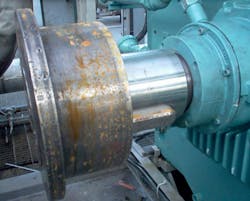Excess vibration destroys bearings, windings, and even the cases of motors. Not only that, the vibration can travel through the pipes, couplings, and other parts of the system to damage gearboxes, pumps, and other equipment.
The causes of vibration are nearly always mechanical. Common culprits:
- Excessive belt tension, in a belt-driven system.
- Bent or misaligned pulley, in a belt-driven system.
- Defective ball or sleeve bearings in the motor, nearly always because of lubrication errors.
- Misalignment of the motor with its load.
- Imbalance caused by a weak motor base or a weak motor pad.
- Gearbox problems (e.g., lubrication defects or excess wear or gear damage) feeding vibration back to the motor.
A very common cause of vibration is an unbalanced rotating member. That member might be the rotor, rotating load, or some component in the drive train. The motor rotor is the least likely culprit. If you uncouple the motor from the load and run it, you’re likely to find the problem isn’t there but in the load.
Don’t wait for your vibration tester to indicate “excess vibration.” It's something that’s hard to define correctly for a specific installation (there are rules of thumb, but use them as starting points).
Trend your vibration measurements and start checking these mechanical sources when vibration shows an increase over time. For critical motors, use a vibration monitoring system that can alert you to changes in vibration.
By trending, you can see the start of a problem that hasn’t yet become full blown. A bearing that is merely galled is much less of a problem than one that has been galled for a long time and finally has spun apart.
About the Author

Mark Lamendola
Mark is an expert in maintenance management, having racked up an impressive track record during his time working in the field. He also has extensive knowledge of, and practical expertise with, the National Electrical Code (NEC). Through his consulting business, he provides articles and training materials on electrical topics, specializing in making difficult subjects easy to understand and focusing on the practical aspects of electrical work.
Prior to starting his own business, Mark served as the Technical Editor on EC&M for six years, worked three years in nuclear maintenance, six years as a contract project engineer/project manager, three years as a systems engineer, and three years in plant maintenance management.
Mark earned an AAS degree from Rock Valley College, a BSEET from Columbia Pacific University, and an MBA from Lake Erie College. He’s also completed several related certifications over the years and even was formerly licensed as a Master Electrician. He is a Senior Member of the IEEE and past Chairman of the Kansas City Chapters of both the IEEE and the IEEE Computer Society. Mark also served as the program director for, a board member of, and webmaster of, the Midwest Chapter of the 7x24 Exchange. He has also held memberships with the following organizations: NETA, NFPA, International Association of Webmasters, and Institute of Certified Professional Managers.
